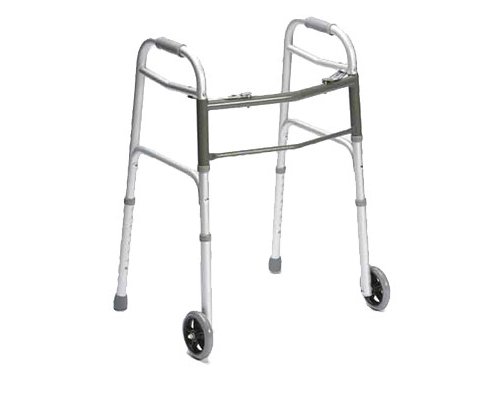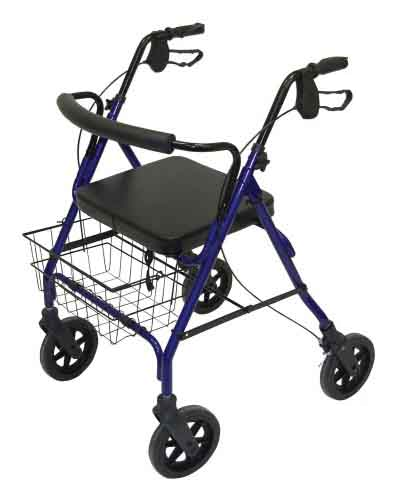



A Comparison of Rollator Vs Wheeled Walking Frame
Rollators and walking frames are walking aids that help senior citizens and people with reduced mobility fulfil their day to day walking needs. While it may be difficult to accept the reality of needing such mobile devices, you or your loved one can take solace in the fact that there are so many options out there for you to choose from.
Both rollators and wheeled walking frames offer their users convenience and serve different purposes for different applications. This blog post explores both devices to help you decide which would be the better option for your needs, let’s dig in!

Wheeled Walking Frames
Walking frames are designed for individuals who need utmost stability and steadiness when walking. They need to be picked up every time the user makes a stride; those who use this aid should have enough arm strength to lift them.
Walkers also come with two wheels in front to aid in quicker mobility; the wheels allow users to walk without having to lift the device on every single stride.
Features and benefits:
-Lightweight aluminium frame for increased mobility.
-Adjustable height for people with different needs.
-Folding capability for convenient and space-savvy storage.
-High traction rubber stoppers for those wet days.
-Front wheels for increased mobility.
-Padded handles to comfortably support your weight.
Cons
-Individuals with weak arm strength may struggle to use this walker.
-Vulnerable to being trapped by holes in the ground.

Rollators
These devices are different from the walkers in their functionality. With wheels installed on all four legs, rollators offer increased mobility for users who can keep up a good pace. The front wheels can swivel and allow you to turn with ease. Rollators have loop brakes for added safety.
For people who don’t have the arm strength for regular walkers, or for those who just don’t need to lift their walker on every stride, and want to walk longer distances, rollators are the way to go. Rollators also have a seat that the user can sit on to take a rest if wanted.
Features and benefits:
-Lightweight aluminium frame for ease of use.
-Folding capability for efficient storage.
-Loop/bicycle brakes for emergency stopping.
-Hand brake locking mechanism that allows users to convert it to a regular walker while traversing uneven or rough terrain.
-8-inch castor wheels for durability.
-Seat with back support for breaks and a basket to carry your essentials.
-Height adjustable handles for variety.
Cons
-Rollators are heavier than regular walkers.
-More moving parts means more maintenance.
Source:SHEERMOBILITY
A Comparison of Rollator Vs Wheeled Walking Frame
Rollators and walking frames are walking aids that help senior citizens and people with reduced mobility fulfil their day to day walking needs. While it may be difficult to accept the reality of needing such mobile devices, you or your loved one can take solace in the fact that there are so many options out there for you to choose from.
Both rollators and wheeled walking frames offer their users convenience and serve different purposes for different applications. This blog post explores both devices to help you decide which would be the better option for your needs, let’s dig in!

Wheeled Walking Frames
Walking frames are designed for individuals who need utmost stability and steadiness when walking. They need to be picked up every time the user makes a stride; those who use this aid should have enough arm strength to lift them.
Walkers also come with two wheels in front to aid in quicker mobility; the wheels allow users to walk without having to lift the device on every single stride.
Features and benefits:
-Lightweight aluminium frame for increased mobility.
-Adjustable height for people with different needs.
-Folding capability for convenient and space-savvy storage.
-High traction rubber stoppers for those wet days.
-Front wheels for increased mobility.
-Padded handles to comfortably support your weight.
Cons
-Individuals with weak arm strength may struggle to use this walker.
-Vulnerable to being trapped by holes in the ground.

Rollators
These devices are different from the walkers in their functionality. With wheels installed on all four legs, rollators offer increased mobility for users who can keep up a good pace. The front wheels can swivel and allow you to turn with ease. Rollators have loop brakes for added safety.
For people who don’t have the arm strength for regular walkers, or for those who just don’t need to lift their walker on every stride, and want to walk longer distances, rollators are the way to go. Rollators also have a seat that the user can sit on to take a rest if wanted.
Features and benefits:
-Lightweight aluminium frame for ease of use.
-Folding capability for efficient storage.
-Loop/bicycle brakes for emergency stopping.
-Hand brake locking mechanism that allows users to convert it to a regular walker while traversing uneven or rough terrain.
-8-inch castor wheels for durability.
-Seat with back support for breaks and a basket to carry your essentials.
-Height adjustable handles for variety.
Cons
-Rollators are heavier than regular walkers.
-More moving parts means more maintenance.
Source:SHEERMOBILITY